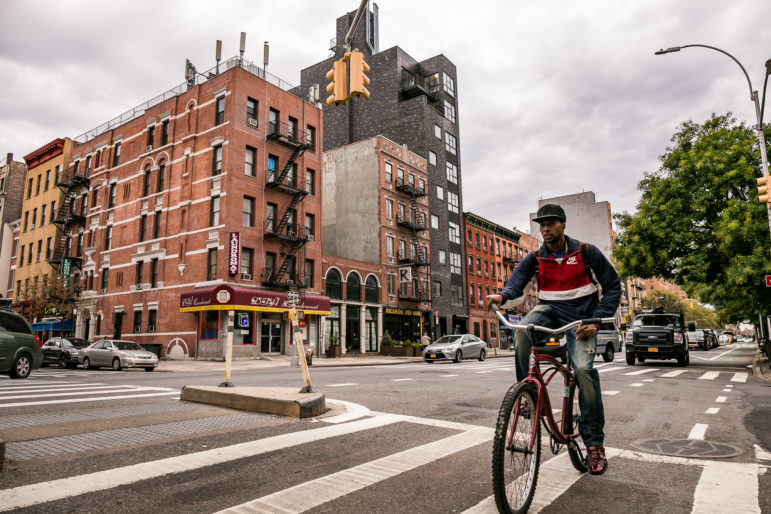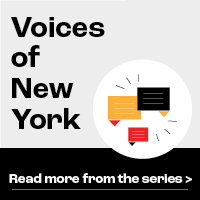
Adi Talwar
A scene from 2nd Avenue and 110th Street in East Harlem, during pre-pandemic times. The neighborhood is the highest number of COVID cases in the borough.Read the original story in Spanish at El Diario
Translated and condensed by Carlos Rodríguez Martorell
“Over there, there is a public housing project where seven people live in a two-bedroom apartment, and they say everyone caught the virus. The older woman, the grandmother, died last week,” said José Ocasio, 68, from Puerto Rico and a resident of El Barrio – as East Harlem is also known – for more than 45 years.
At press time, the Manhattan neighborhood, which has a majority of Latino residents, stands out for being the most affected by the COVID-19 pandemic in the borough. Of the 40 zip codes comprising Manhattan, 10029 is highlighted in bright red in the New York City Department of Health and Mental Hygiene’s (DOHMH) map of the spread of the coronavirus in the city.
The number of recorded cases in that area was at around 2,900 as of April 19, while other parts of the borough, particularly in the southeastern part of the island, reported fewer than 400 cases.
“When a plague comes to New York, it always hits Harlem hard. AIDS, crack … Everything bad always punishes us harder,” said Ocasio, who lives in a public housing development on 116th Street and Lexington Avenue.
In the words of former City Council Speaker Melissa Mark-Viverito, it’s no surprise that the effects of the pandemic have been felt more strongly in one of the country’s poorest areas.
“COVID-19 came to lay bare, yet again, what we already knew: That this system of inequality and this historical legacy of racism have resulted in poor investment in our communities. That is why Latinos and Blacks in New York are major victims in this emergency,” said the Puerto Rican-born political leader.
Of all El Barrio residents, 52.1 percent identified as Latinos or Hispanic in the 2010 Census. Of those, 27.7 percent were Puerto Rican.
The New York City Housing Authority (NYCHA) manages more than 15,000 units in 24 residential complexes in East Harlem, the highest number of public housing apartments in the city’s 59 community districts.
These developments for low-income families represent over a third of all apartment rentals in El Barrio. They seem to be one of the main focal points of the pandemic.
“Here, where you can have two families living in a small apartment, the coronavirus spreads much faster,” a resident interviewed by El Diario pointed put.
Residents of NYCHA’s East River Houses, which has 1,158 apartments, say it has been hard for the majority of the 3,000 people who live there to adopt strict quarantine measures because many of them are essential workers who perform hospital maintenance and cleaning duties.
“One of the first people to die here was a subway worker,” a Puerto Rican resident of the complex, who chose to remain anonymous, said over the phone. “You see a lot of movement of people coming and going, sitting on the steps. The hygiene is lacking. Obviously, some of the workers are bringing that demon in here. We know of whole families who have gotten sick and have not been tested.”
Health authorities could not confirm whether the majority of COVID-19 cases in the neighborhood had been detected in public housing developments.
As the coronavirus continues to spread, NYCHA has told local media that they are aggressively cleaning their 2,200 buildings three times per week through a combination of internal staff and external cleaning services.
The city agency states that they are concentrating on the high-traffic areas of the 361 complexes, including doors in common areas, mailboxes and elevator buttons.
For its 71 buildings for older adults, NYCHA hired a private company to clean five times per week with a “hospital-grade disinfectant aerosol” called Smart Touch. The same surfaces are being treated with BioProtect, a water-based protective coating that is said to last up to 90 days.
A NYCHA spokesperson said the method will be applied in 30-day cycles as an additional precaution, in addition to routine cleaning.
DOHMH authorities have also announced a series of emergency policies aimed at reducing overcrowding, which is common in some housing complexes. Such conditions make it impossible to isolate patients who do not require hospitalization, and enable the spread of the virus.
Dr. Oxiris Barbot, New York City’s health commissioner, said 11,000 hotel rooms are being prepared to guarantee isolation conditions for this type of patient.









8 thoughts on “‘The Virus Spreads Faster Here’: El Barrio Tops Manhattan’s COVID-19 Rate”
I LIVE IN 10029 AND AM PLAGUED WITH COVID 19 AND PNEUMONIA. AS OF YET NO STEPS HAVE BEEN TAKEN TO EDUCATE AND INFORM THIS AREA OF THE SERIOUSNESS OF THIS PANDEMIC. AS WALK THRU JEFFERSON PARK BY 1199 HOUSING NO MASK NO BOUNDARIES WITH THE EXCEPTION OF A SMALL FEW.GUESS IT GONNA TAKE NOTHING SHORT OF CONTRACTING BEFORE THEY UNDERSTAND!!
wow
The upper end of the East Side is called Bedpan Alley because of the intense concentration of hospitals there. I wonder what percent of East Harlem residents work in those hospitals in lower-paid professions than doctors and nurses.
I live in far Rockaway housing.
And there is no cleaning of building ..
Elevator. Staircases..hall..floors are not being clean on regular s schedule
It’s so sad that our communities are always ignored and and forgotten about That’s is exactly why our communities suffer the most
I pray you have a speedy recovery George
To all my people of Harlem please stay safe and healthy
God bless us all
Correction: Tough and healthy, not touch and healthy.
I am seriously praying for my community here in East Harlem. I watch every day and night as people gather and visit one another sometimes without masks on. Many are acting like they are untouchables who won’t get this virus. It breaks my heart and baffles me. My own family members who live in separate apartments besides me are not even doing things they are suppose to be doing like social distancing more, wearing masks always and not visiting family or friends. Please, let’s pray that God will have mercy on us and that He will help bring about the cure for this covid-19, testing for all, meducation(s) and the safe vaccine for this dreadful virus.
Where are the mayor and the governor .?